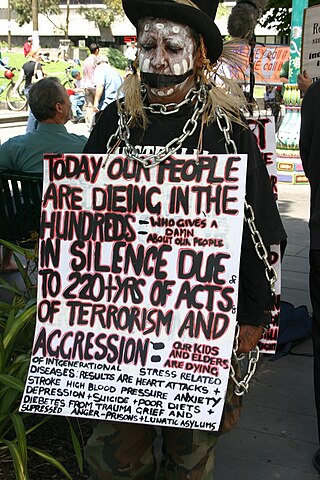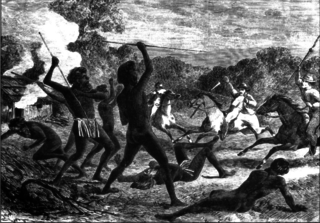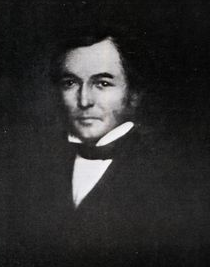
The Black War was a period of violent conflict between British colonists and Aboriginal Tasmanians in Tasmania from the mid-1820s to 1832 that precipitated the near-extermination of the indigenous population. The conflict was fought largely as a guerrilla war by both sides; some 600 to 900 Aboriginal people and more than 200 British colonists died.

The Waterloo Creek massacre refers to a series of violent clashes between mounted settlers, civilians and Indigenous Gamilaraay people, which occurred southwest of Moree, New South Wales, Australia, during December 1837 and January 1838.

Kyneton is a town in the Macedon Ranges region of central Victoria, Australia. The Calder Freeway bypasses Kyneton to the north and east.

The Myall Creek massacre was the killing of at least 28 unarmed Aboriginal people in the Colony of New South Wales by eight colonists on 10 June 1838 at the Myall Creek in the north of the colony. Seven perpetrators were convicted of murder and hanged.

Sir George Gipps was the Governor of the British Colony of New South Wales for eight years, between 1838 and 1846. His governorship oversaw a tumultuous period where the rights to land were bitterly contested in a three way struggle between the colonial government, Aboriginal people and wealthy graziers known as squatters. The management of other major issues such as the end of convict transportation, large immigration programs and the introduction of majority elected representation also featured strongly during his tenure. Gipps is regarded as having brought a high moral and intellectual standard to the position of governor, but was ultimately defeated in his aims by the increasing power and avarice of the squatters.

The Taungurung people, also spelt Daung Wurrung, are an Aboriginal people who are one of the Kulin nations in present-day Victoria, Australia. They consist of nine clans whose traditional language is the Taungurung language.
The following lists events that happened during 1838 in Australia.
Henry Edmund Pulteney Dana (1820–1852) established the Native Police Corps in the Port Phillip District in 1842, he was responsible for two massacres of Aboriginal people one at Barmah Lake in 1843 and the other at Snowy River in 1846. Dana was born in England, his father being Captain William Pulteney Dana of the 6th Regiment. Henry Dana migrated to Van Diemen's Land in 1840, but in 1842 he relocated to the Port Phillip District where he renewed acquaintance with Superintendent Charles La Trobe, whom he knew in London. The two men became firm friends and Latrobe appointed Dana to establish a native police corps.

Barfold is a locality on the Heathcote-Kyneton Road (C326) in Victoria, Australia. It has a community hall, Barfold Hall, and an Anglican church, Barfold Union Church.

The Djadjawurrung or Dja Dja Wurrung, also known as the Djaara or Jajowrong people and Loddon River tribe, are an Aboriginal Australian people who are the traditional owners of lands including the water catchment areas of the Loddon and Avoca rivers in the Bendigo region of central Victoria, Australia. They are part of the Kulin alliance of Aboriginal Victorian peoples. There are 16 clans, which adhere to a patrilineal system. Like other Kulin peoples, there are two moieties: Bunjil the eagle and Waa the crow.
The Campaspe Plains massacre in 1839 in Central Victoria, Australia was as a reprisal raid against Aboriginal resistance to the invasion and occupation of the Dja Dja Wurrung and Taungurung lands. Charles Hutton took over the Campaspe run, located near the border of Dja Dja Wurrung and Taungurung, in 1838 following sporadic confrontations.

The Australian frontier wars were the violent conflicts between Indigenous Australians and mostly British settlers during the colonial period of Australia.

The Rufus River Massacre was a massacre of at least 30–40 Aboriginal people that took place in 1841 along the Rufus River, in the Central Murray River region of New South Wales. The massacre was conducted by a large group of South Australian Police, who were sent to the region by the Governor of South Australia, George Grey, after Indigenous warriors carried out a series of effective raids against settler overland drives. The police were augmented by armed volunteers and a separate party of overlanders who were already battling with Aboriginal people in the Rufus River area. The colony's Protector of Aborigines, Matthew Moorhouse, accompanied the punitive expedition. He was unsuccessful in his efforts to mediate a solution before the massacre occurred.

Myall Creek Massacre and Memorial Site is the heritage-listed site of and memorial for the victims of the Myall Creek massacre at Bingara Delungra Road, Myall Creek, Gwydir Shire, New South Wales, Australia. The memorial, which was unveiled in 2000, was added to the Australian National Heritage List on 7 June 2008 and the New South Wales State Heritage Register on 12 November 2010.
The Eumeralla Wars were the violent encounters over the possession of land between British invaders and Gunditjmara Aboriginal people in what is now called the Western District area of south west Victoria.
Myall Creek is a rural locality split between the local government areas of Inverell Shire and the Gwydir Shire in New South Wales, Australia. In the 2021 census, Myall Creek had a population of 27.

Thomas Simpson Hall was an Anglo-Australian pastoralist who was at the forefront of British colonial expansion into what is now northern New South Wales and southern Queensland. He established large pastoral leases in these areas on Aboriginal lands and was subsequently involved in considerable frontier conflict with these original occupants. Hall was a pioneer of the British settlements of Dartbrook, Manilla, Bingara, Moree and Surat. He also became a leading breeder of Shorthorn cattle in Australia and developed a type of working dog called the Halls Heeler, from which the Australian cattle dog is descended.

Winberri was an Indigenous Australian resistance leader who, in 1840, led an armed group of Taungurung men in a campaign against British colonists in what is now called central Victoria. Also known as Winberry, Tinbury, or Windberry, he was shot dead in October 1840 by the New South Wales Mounted Police while they were arresting him during the Lettsom raid.












